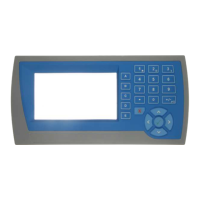EMC INDUSTRIAL GROUP LTD Inputs
MW61A_IM_ALL_SV6.09d_en 27/47
Calibrate Using Loadcell Specifications
The loadcell can be calibrated using the loadcell(s) capacity and sensitivity supplied by the manufac-
turer. Using this method avoids the need to load and unload test weights onto the weighing system. If
the system has already been calibrated using test weights, the actual dead load and loadcell sensitivity
are displayed. These settings should not then be adjusted.
1. Press the Q key to access the setup menu.
2. Key in the quick key code 22331 to select the ‘loadcell capacity’ step.
3. Press the EDIT key. (If editing is locked, key in the password 111 and press ENTER).
4. Key in the total loadcell capacity followed by ENTER. This is normally the sum of all of the
loadcell capacities (e.g. 4 x 100kg loadcells = 400kg total capacity).
5. Press BACK then 2 (or press the DOWN key) to move to the ‘system sensitivity’ step
(QK 22332).
6. Key in the loadcell sensitivity followed by ENTER. This is normally the average of all of the
loadcell sensitivities.
7. Press BACK then 3 (or press the DOWN key) to move to the ‘deadload’ step (QK 22333).
8. If you know or can estimate the deadload, key this in followed by ENTER. This value is the
total weight of the mechanical components applied to the loadcell but excluding any material
weight.
9. Press and hold the BACK key to return to normal operation.
If the deadload is unknown (as is usually the case), a loadcell zero should be performed.
1. Press the Q key to access the setup menu.
2. Key in the quick key code 22321 to select the ‘AI1 zero’ step.
3. Make sure all material and test weights are removed from the weighing system.
4. Press the EDIT key. (If editing is locked, key in the password 111 and press ENTER).
5. Press the 0 key followed by ENTER to initiate a zero calibration.
6. Press and hold the BACK key to return to normal operation.
Loadcell signals
These settings are used for diagnostics and fault detection on the loadcell input.
Q22351 AI1 signal 8700 mV/V
Displays the loadcell signal in mV/V.
Q22352 AI1 signal P 8710 mV/V
Q22353 AI1 signal Q 8712 mV/V
Q22354 AI1 signal R 8716 mV/V
Q22355 AI1 signal S 8718 mV/V
Displays each loadcell signal when scanning has been enabled. (refer to Q22314)
Q22350 loadcell check 8914, g7 off=0
Set to 1 (on) to measure mV/V signal of each loadcell.
Loadcell trim
These settings are used to trim the input gain of up to four loadcells. This can be used to correct for
sensitivity differences when using 2, 3 or 4 loadcells. A typical application is corner adjustment of a
platform scale.
Q22361
trim 1 [-1250 to 1251]
8132, g7 disabled =1251
Q22362
trim 2 [-1250 to 1251]
8134, g7 disabled =1251
Q22363
trim 3 [-1250 to 1251]
8136, g7 disabled =1251
Q22364
trim 4 [-1250 to 1251]
8138, g7 disabled =1251
The trim settings are set to 1251 when not in use, which sets the excitation voltages to their maximum.
Corner adjustment procedure:
1. Set trim 1 through to excitation 4 to the value 0.
2. Calibrate the scale (zero and span) with the test weights applied centrally.
3. Apply the test weight as close to loadcell1 as possible, adjust the setting ‘trim 1’ so that the
weight reading corresponds to the test weight value.
4. Repeat for each of the remaining loadcells.
Current/Voltage input
When AI2 is available, a remote setpoint signal can be connected as either a current (eg 4 to 20mA) or
as a voltage (eg 0 to 10V). The transmitter auto-detects whether the current or voltage input is active
and uses the relevant calibration from the following settings.
Q2241 AI2 current low 8140, g2 4.000 mA
This is the low point of the analog signal (when using the current input) within the range 0 to 20 mA
(typically set this variable to 4 mA).

